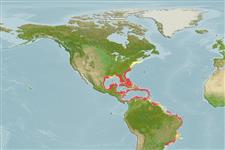Classification / Names
आम नाम | उपशब्द | Catalog of Fishes (gen., sp.) | ITIS | CoL | WoRMS | Cloffa
ऐकटीनोप्टीरेजी (रेज़-फिन्नढ मछलियाँ) >
Perciformes (Perch-likes) >
Lutjanidae (Snappers) > Lutjaninae
Etymology: Ocyurus: Greek, okys = quick + Greek, oura = tail.
पर्यावरण / जलवायु / सीमा
पारिस्थितिकी
; समुद्री प्रवाल-भित्ति संयुक्त; गहराई सीमा 0 - 180 m (Ref. 10795), usually 10 - 70 m (Ref. 55229). Subtropical, preferred 26°C (Ref. 107945); 42°N - 26°S, 98°W - 31°W (Ref. 55229)
Western Atlantic: extending northward to Massachusetts, USA and Bermuda and southward to southeastern Brazil, in Gulf of Mexico and Antilles (Anderson, pers. comm.). Most common in the Bahamas, off south Florida and throughout the Caribbean. Lutjanus ambiguus (Poey, 1860), an intergeneric hybrid with Lutjanus synagris (Linnaeus) as demonstrated by Loftus (1992: Ref. 33006), followed by McEachran &. Fechhelm (2005: Ref. 78464).
Length at first maturity / आकार / वज़न / Age
Maturity: Lm 22.5, range 15 - 31 cm
Max length : 86.3 cm TL पुल्लिंग / अलिंग; (Ref. 9626); common length : 40.0 cm TL पुल्लिंग / अलिंग; (Ref. 55); अधिकतम प्रकाशित वज़न: 4.1 kg (Ref. 40637); अधिकतम सूचित उम्र: 14 वर्षो (Ref. 3090)
पृष्ठीय रीढ़ (सम्पूर्ण): 10; पृष्ठीय सौफट रेज़ (सम्पूर्ण): 12-14; गुदा कांटा 3; ऐनल सौफट रेज़: 8 - 9. Head relatively small, lower jaw projecting slightly beyond the upper. Scale rows on back rising obliquely above lateral line. Back and upper sides blue to violet with scattered yellow spots. A prominent mid-lateral yellow band running from the snout to the caudal fin base. The lower sides and belly whitish with narrow reddish and yellow stripes; the dorsal and caudal fins yellow; the anal and pelvic fins whitish.
Adults inhabit coastal waters, mostly around coral reefs. Usually seen well above the bottom, frequently in aggregations. They feed on a combination of plankton and benthic animals including fishes, crustaceans, worms, gastropods and cephalopods, mainly at night (Ref. 9987). Young individuals are usually found over weed beds. They feed primarily on plankton (Ref. 9710). Spawning occurs throughout the year, with peaks at different times in different areas (Ref. 26938). Marketed fresh and frozen (Ref. 9987). Has been reared in captivity (Ref. 35420).
Allen, G.R., 1985. FAO Species Catalogue. Vol. 6. Snappers of the world. An annotated and illustrated catalogue of lutjanid species known to date. FAO Fish. Synop. 125(6):208 p. Rome: FAO. (Ref. 55)
IUCN Red List Status (Ref. 115185)
CITES (Ref. 94142)
Not Evaluated
Threat to humans
Reports of ciguatera poisoning (Ref. 30911)
Human uses
मात्स्यिकी: व्यापारिक; जलीयकृषि: व्यापारिक; आखेट मत्स्य: हां; जलजीवालय: सार्वजनिक लजीवालय
साधन
Special reports
Download XML
इंटरनेट स्रोत
